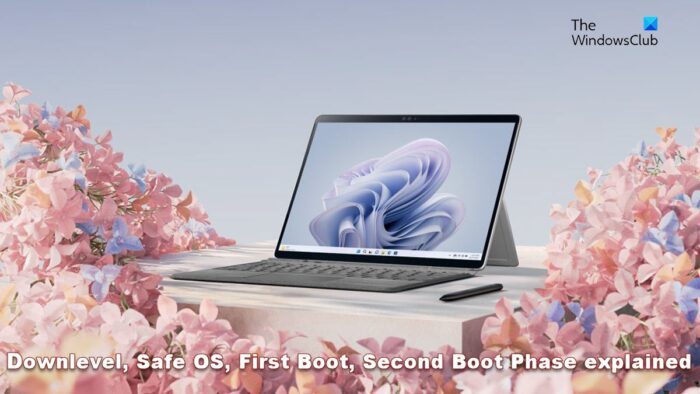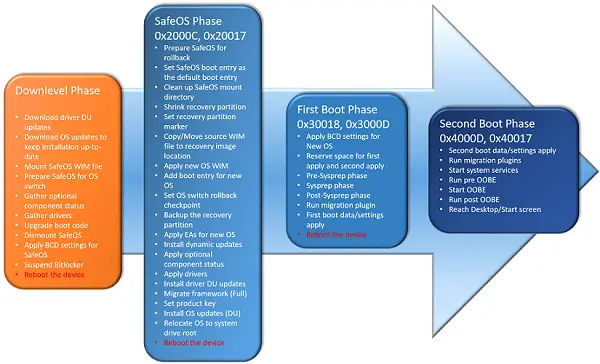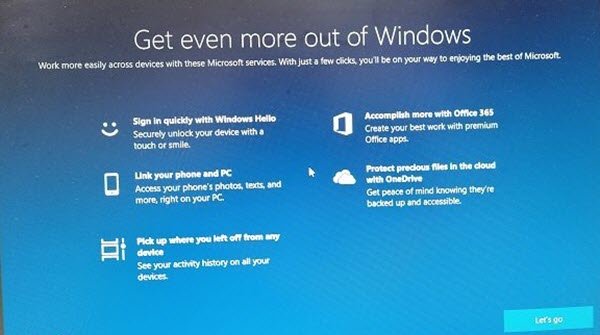If you want to know what Downlevel, Safe OS, First Boot, and Second Boot Phases are in a Windows Upgrade process, then read this post. An upgrade moves your system from an existing version of Windows to a new version. It can also migrate your system from one edition of a Windows version to a different edition of the same version. When this happens, a lot of changes take place internally.

Downlevel, Safe OS, First Boot, Second Boot Phase explained
There are 4 key stages involved in an in-place Windows upgrade process: Downlevel, Safe OS, First Boot, and Second Boot. An in-place upgrade installs a new version of Windows without removing the previous version from the system. This type of upgrade scans the system for new OS compatibility and then uses the Windows Setup application to install the new version from an installation media, such as a USB key, a mounted .ISO file, a network device, or a DVD.
The Windows Setup application is a bootable installer program that upgrades a system to Windows 11/10 or performs a clean installation. While performing a system upgrade, it goes through 4 different phases:
- Downlevel Phase
- Safe OS Phase
- First Boot Phase
- Second Boot Phase
Let us understand these phases one by one.

1] Downlevel Phase
Downlevel phase is the first phase of the Windows upgrade process. It runs on the existing OS and checks the system for new OS compatibility, such as available RAM (1Gb for 32-bit, 2Gb for 64-bit), primary storage class drivers, network class drivers, drivers for hardware not currently connected to the system, inventory products, and patches, etc. It then uses Windows Updates to install the latest updates if not already present in the Windows Installation Media download. Then compares the inventory for database compatibility. And administers boot-critical drivers into Windows Recovery Environment.
2] Safe OS
Also known as the setting up phase, this is the second phase in the Windows upgrade process. During this phase, a backup of the downlevel OS is created to switch to the old OS if required. This basically includes hard links to already existing content. Some drivers are administered into the new OS which is then laid down on a disk in a folder hierarchy. Some offline mitigation tasks are also performed during this phase.
3] First Boot
Next is the First Boot phase. During this phase, an instance of the new OS is created and bound to the machine. Then 1st boot to the new OS is performed and initial settings are applied. Installation of drivers, migration of applications, and some other migration tasks are also performed during this phase.
4] Second Boot

Also known as the OOBE (Out-Of-Box Experience) boot phase, this is the last and final phase in the Windows upgrade process. During this phase, 2nd boot to New OS (or clean boot to the final OS) is performed and final settings (hardware and software configuration settings) are applied. Windows Welcome Screen appears when the user starts the system for the first time and is prompted to enter his account information, choose language, accept Microsoft Terms of Service, set up a network, set up sign-in with Windows Hello, etc.
After each of these phases, the system reboots to apply changes. This winds up Downlevel, Safe OS, First Boot, and Second Boot Phases explained. Hope you find the information useful.
If the upgrade succeeds, you don’t have to bother about these changes. But if it fails (which happens many times), it’s good to understand the basics of the upgrade process in advance, to help troubleshoot common Windows Upgrade problems.
Do let us know in the comments section if you have any questions.
Where are Windows 11 install logs?
When you upgrade from an earlier version of Windows to a new version, several log files are created during each phase of the upgrade process. These log files correspond to a successful or a failed upgrade and help determine what went wrong with the upgrade. You may find some of these log files at C:\$Windows.~BT\Sources\Panther, C:\$Windows.~BT\Sources\Rollback, and C:\$Windows.~BT\Sources\Panther\UnattendGC.
What is the OOBE screen in Windows?
OOBE, also known as the Out-Of-The-Box Experience screen, is the first screen you see when you turn on your computer after a successful Windows upgrade. This screen guides you through a series of steps to set up Windows using a local account or a Microsoft account and proceed with standard settings of the Windows 11/10 OS.
Related read: How IT administrators can troubleshoot Windows Upgrade errors.